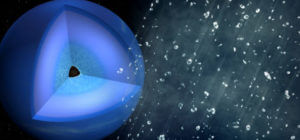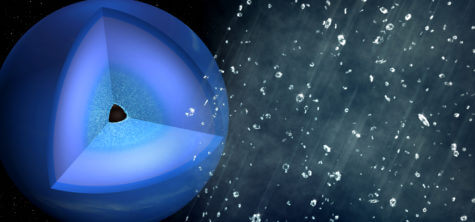MENLO PARK, Calif. — “Diamond rain” is a natural phenomenon that occurs in the two icy gas giants of our solar system, Uranus and Neptune. Now researchers from the Stanford Linear Accelerator Center (SLAC) have found a way to recreate the spectacular sparkling event in their laboratory for the first time ever.
Using SLAC’s X-ray free-electron laser and what’s known as the Matter in Extreme Conditions (MEC) apparatus, scientists mimicked the conditions deep within an icy gas giant like Neptune to create the diamond rain. Extreme pressure in the interior of the planet squeezes hydrogen and oxygen into solid diamonds that sink deeper into the planet.

Scientists in the past theorized that this phenomenon occurs about 5,000 miles below the surface of Uranus and Neptune. At the center of both of these planets, a solid core spins with dense layers of slushy ice rotating along with it.
The researchers created diamond rain conditions by creating shock waves in plastic using an optical laser at the MEC instrument. Scientists then observed that almost every carbon atom in the plastic fused with the small diamond structures up to a few nanometers wide — much smaller than scientists expected. They believe the diamonds may grow to be potentially millions of carats in weight. Then, over thousands of years, the massive diamonds penetrate the planets’ icy layers to form a layer of their own around the core.
Of course, this wasn’t about creating giant diamonds. For the scientists, this was about witnessing an event that’s only been imagined until now.
“Previously, researchers could only assume that the diamonds had formed,” explains Dominik Kraus, scientist at Helmholtz Zentrum Dresden-Rossendorf and lead author of the study. “When I saw the results of this latest experiment, it was one of the best moments of my scientific career.”
Learning how elements mix with each other and form new materials at high pressures within planets can help scientists determine the chemical makeup of distant exoplanets, or planets beyond our solar system.
For more on the technology Kraus and his research team used to make this breakthrough discovery, read more from the SLAC.
The full study was published Aug. 21, 2018 in the journal Nature: Astronomy.

Comments
Comments are closed.